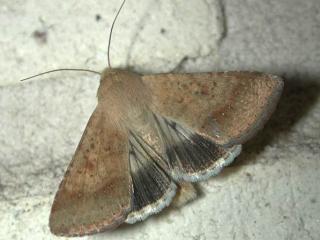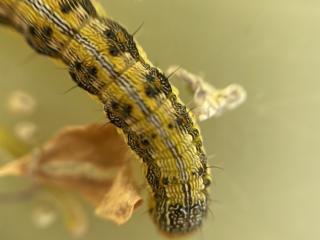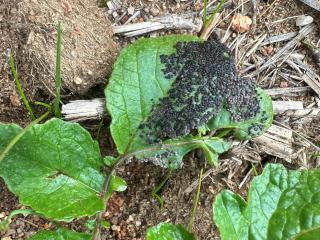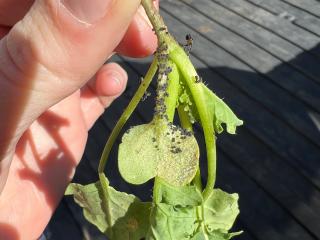Native budworm are active early
- Nolba
- Marrah
- Moonyoonooka
- Wicherina
- Southern Cross
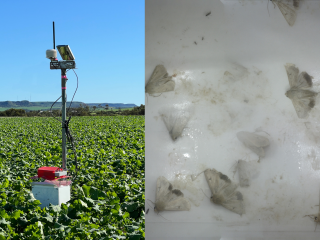
Native budworm moths have recently been detected as bycatch in the Department of Primary Industries and Regional Development (DPIRD)’s automated Diamondback moth (DBM) traps. This is surprising, as DBM traps are not designed to attract native budworm moths. This may indicate that large numbers of DBM are present and are randomly flying into traps.
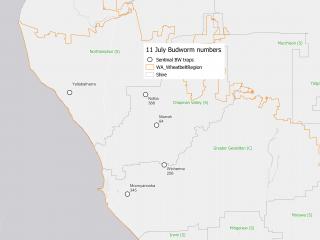
DPIRD staff responded by setting up five sentinel native budworm traps in the Geraldton zone ahead of the planned July to October trapping network. Early budworm flights were detected over a two week period. 345 native budworm moths were caught at Moonyoonooka, 256 moths at Wicherina, 84 moths at Marrah and 388 moths at Nolba.
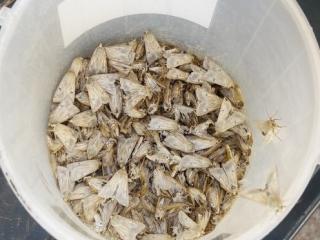
At the Moonyoonooka trapping site, very low numbers of native budworm caterpillars were sweep netted in the canola paddock, with less than one caterpillar per 10 sweeps. Staff did not find caterpillars at the other trapping sites.
Six native budworm moths have also been captured in a trap near Southern Cross.
The high numbers of moth captures are of concern and indicate that native budworm moths have begun to migrate into the grain growing areas in the northern and north eastern grainbelt areas, and are likely to have already started laying eggs onto crops. Native budworm moths migrate long distances annually from the north and eastern pastoral areas, moving south and west into the grainbelt.
Growers will need to be vigilant over the next couple of weeks by checking their lupin, canola and pulse crops for the presence of native budworm caterpillars. Serradella, lucerne, clover and annual medic seed crops should also be checked.
During average spring temperatures, it takes about seven days for any native budworm eggs laid on crops to hatch into caterpillars. It then takes a further two weeks for the caterpillars to grow to about 5mm, when they can then be detected in sweep nets. With cooler winter temperatures prevailing in many areas, the caterpillar life cycle is likely to take longer than three weeks to reach the size of 5mm.
The small caterpillars will cause minor leaf damage that is not obvious, such as tiny holes chewed into leaves. This means that they can initially go unnoticed if crops aren’t being checked with a sweep net. The young caterpillars feed on leaf or pod material for about two weeks before they become large enough (5mm long) to be noticed in the crop.
However, as the caterpillars get larger they can cause severe damage particularly if they coincide with pulse crops budding, flowering or early pod formation.
It takes a further four weeks until they are fully grown (40mm) which is about seven weeks from the time of egg laying. These development times are based on average spring temperatures, and while temperatures are still relatively warm in the northern agricultural region, these development times will be extended in areas experiencing cooler winter temperatures.
A mapped view of the native budworm trap captures is available at Cesar Australia’s MothTrapVisWA page. Viewers need to select the desired trapping date range.
Detailed information on this pest can be found at the department’s Management and economic thresholds for native budworm.
Pesticide options for the control of native budworm can be found in DPIRD’s 2023 Winter Spring Insecticide Guide.
For more information contact Technical Officer Alan Lord, South Perth on +61 (0)8 9368 3758 or +61 (0)409 689 468.
Article authors: Alan Lord (DPIRD South Perth) and Christiaan Valentine (DPIRD Northam).
Article input: Bec Severtson (DPIRD Northam).
Powdery mildew
- Tammin
- Cunderdin
- Moorine Rock
Dan Taylor (DKT Rural Agencies) has recently found powdery mildew lesions on six leaf Scepter (susceptible) wheat near Tammin and on wheat volunteers in a paddock corner near Cunderdin.
Powdery mildew has also been found on tillering Corack (very susceptible) wheat near Moorine Rock.
When diagnosing powdery mildew look for fluffy, white powdery growths of fungal spores on the surface of leaves and leaf sheaths. Infection usually starts low in the canopy and under severe disease pressure can appear on stems and heads. As the infection ages there is a yellowing of the infected tissue, and the infected area turns a dull grey colour with small black specks present. A powdery mildew infected crop may appear yellow from a distance. Details and more photos of the symptoms of powdery mildew are available on DPIRD’s Diagnosing powdery mildew in cereals page.
Powdery mildew is favoured by mild temperatures (15–22°C) and high humidity (in excess of 70%). Dense crop canopies, high nitrogen nutrition and extended periods of canopy humidity are factors that are understood to favour mildew development. Dry and warm weather conditions that result in periods of low canopy humidity and temperatures above 25°C can reduce disease development. Constant rains can help supress mildew development temporarily.
Barley and wheat powdery mildew pathogens are host specific and do not cross infect.
Current seasonal conditions are favourable for powdery mildew. This means that in some areas of the grainbelt, growers should monitor wheat and barley crops for this and other diseases, particularly in areas where a pre-season green bridge was apparent or susceptible varieties have been sown.
For barley and wheat variety disease ratings, refer to the department's 2023 Crop Sowing Guide for WA. Infection early in the season on susceptible to moderately susceptible varieties can significantly reduce yield (by up to 25%) while infection at later stages (after Z39) is usually less damaging.
Seed dressing or in-furrow products, such as flutriafol, applied to manage other diseases may provide some degree of protection from powdery mildew. Note that these products are not registered for this use.
Registered foliar fungicides can be used to control powdery mildew infection. Application early in the epidemic before significant disease (e.g. first application around stem elongation) development is most effective. For more information, refer to the Department’s Registered foliar fungicides for cereals in Western Australia page.
Fungicide resistance
There are currently no records of fungicide resistance in wheat powdery mildew in WA. However, reports of mutations affecting Group 11 and Group 3 fungicides in eastern Australia show the need for appropriate fungicide resistance management strategies in WA.
If you suspect fungicide resistance in your paddock, then researchers at the Centre for Crop and Disease Management (CCDM) would love to hear from you. To get in touch please email CCDM’s fungicide resistance team at frg@curtin.edu.au .
More information on fungicide resistance can be found in the Australian Fungicide Resistance Network’s (AFREN) Fungicide resistance management in Australian grain crops publication .
Further information
For more information on powdery mildew, visit DPIRD’s Diagnosing powdery mildew in cereals and Managing powdery mildew in wheat pages.
For more information, contact Plant pathologists Geoff Thomas in South Perth on +61 (0)8 9368 3262, Andrea Hills in Esperance on +61 (0)8 9083 1144, Ciara Beard in Geraldton on +61 (0)8 9956 8504, or Kithsiri Jayasena in Albany on +61 (0)8 9892 8477.
Article authors: Kithsiri Jayasena (DPIRD Albany), Andrea Hills (DPIRD Esperance), Geoff Thomas (DPIRD South Perth) and Ciara Beard (DPIRD Geraldton).
Slime mould
- Goomalling
Slime mould has recently been found on canola plants and forage Buster radish near Goomalling.
Slime moulds generally appear on decaying plant material as patches of watery or jelly-like slimy material. After a few days, the jelly-like material produces fruiting bodies are commonly ash grey, though in some instances they may be bright yellow or red. These fruiting bodies usually occur in great numbers on the affected plant material, and may cover an area of up to a square metre.
Warm wet weather combined with high nitrogen levels provide a good environment for the slime moulds.
The slime moulds should disappear if a couple of dry warm days are experienced.
No control measures are required for slime moulds. If you have concerns about your livestock eating slime moulds, please contact your local veterinary officer.
For more information, refer to the department’s Slime moulds page.
For more information contact Senior research scientist Geoff Thomas, South Perth on +61 (0)8 9368 3262.
Article author: Cindy Webster (DPIRD Narrogin).

